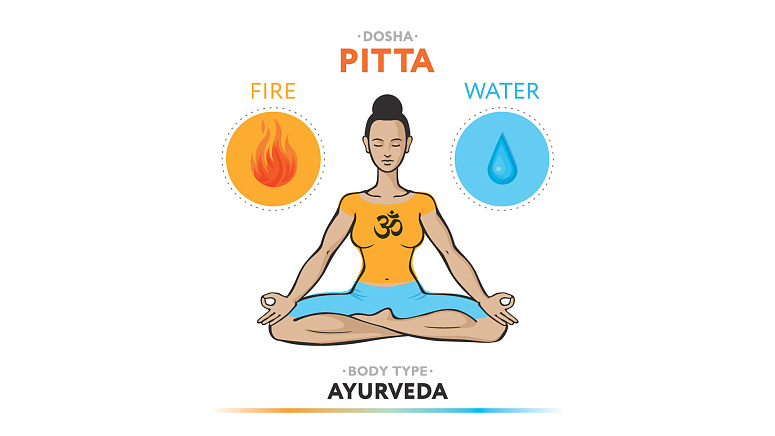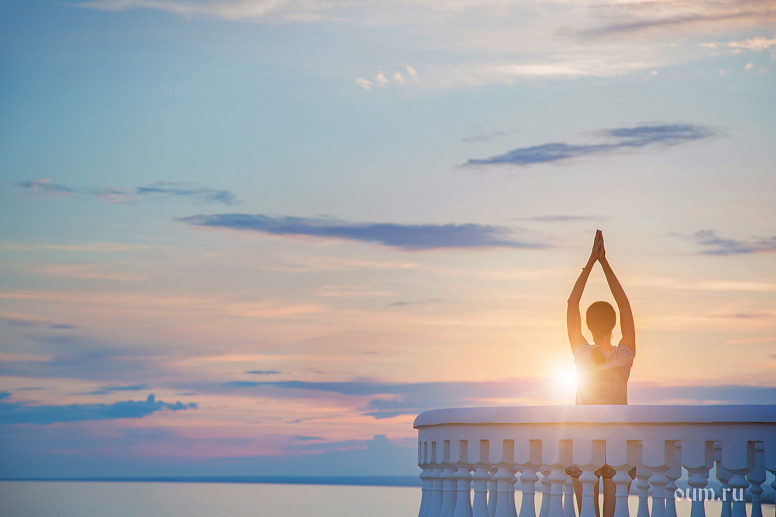According to Ayurveda, Pitta dosha is a combination of fire and water. It is responsible for forming bile and metabolic processes in the body. Predominant Pitta in the body influences body structure and character, behavior and food preferences, attitude to life, and intelligence more than other doshas.
Pitta dosha characteristics
Pitta is associated with digestive fire, heat of the body and radiance of the mind. If in balance, it stimulates action and forward movement. However, left unattended, it can get out of control and become a fire that scorches everything around it. Watching your internal “fire”level is essential to keep the balance.
The Pitta's area of responsibility is the stomach, upper small intestine, liver, gall bladder, spleen, heart, eyes and brain. It regulates the processes of sweating, blood flow and lymph flow. Moreover, it affects endocrine glands and skin health.
Excess Pitta causes skin diseases and allergic reactions and provokes hormonal disorders, digestive system problems and various eye disorders.
Pitta deficiency results in poor digestion, slow metabolism, and thought lethargy.
If the fire of body and mind is imbalanced, anger, wrath, envy, jealousy and dissatisfaction with everyone and everything can overwhelm you and make your life a living hell.
How to recognise Pitta dosha?
There are three doshas in the human body, which interact with each other. However, one of them is usually dominant and, therefore, influences an individual's behaviour and physical conditions more than the other doshas.
Pitta-dominated people are easily recognisable by the following character traits:
- motivated, energetic and passionate about their work;
- persistent, determined and demanding;
- bossy, ambitious and even aggressive;
- with a lively mind, imaginative thinking, as well as wit and worldly wisdom;
- with good memory and logic, as well as a tendency to easily solve puzzles and non-trivial tasks;
- natural orators and organisers;
- prone to be the centre of attraction, the guiding force and leaders;
- prone to saving money and preferring first-class items.
- effective appearance;
- well-proportioned and athletic;
- average height and weight. Moreover, these people gain weight gradually and quickly lose it if needed;
- confident gait and straight back;
- thin and light skin that burns quickly in the sun;
- moles all over the body;
- average to slightly oily and often freckled skin on the face;
- acne, skin inflammation and allergic rashes;
- thin red or blonde hair that turns grey early;
- soft but strong nails with a beautiful oval shape;
- lively look with a twinkle in the eye. As for the eyes, they should be protected from bright sunlight;
- straight but not white teeth with gums prone to bleeding;
- inflamed and chapped lips;
- sweating and strong body odour;
- good appetite and digestion;
- tendency to fatty and spicy food, as well as to ice-cold drinks;
- shallow sleep and a tendency to fall asleep quickly.
- At the physiological level, Pitta is responsible for digestion and bile production. Therefore, signs of imbalance are heartburn, heaviness in the stomach, vomiting, allergies, skin rashes and acne.
- Since people with Pitta constitution usually know that they have excellent digestion, they are prone to overeating and abusing junk food. But still, when eating indiscriminately, even active fire will fail, and the digestive system will begin to malfunction. Above all, pitta-dominated people should remember that the body and mind must be cooled down for balance.
- Emotionally, people with unbalanced Pitta become acrimonious, irritable and envious. Pitta dosha belongs to the element of fire expressed in passion, Rajas, which often leads to vanity and narcissism. Thus, when the balance is disturbed, arrogance and pride are manifested.
- Ayurveda teaches that the Pitta-dominated people must overcome their egoism, learn to respect people and be compassionate to them; be concerned about their needs. Once they learn patience and calmness, directing their inner energy toward creation will become easier. Otherwise, the energy will turn destructive. One of the best ways to achieve balance is practicing sincere apologies and cordial forgiveness; never suppress negative emotions, but accept all events as gifts of fate.
- non-carbonated drinks, herbal teas, natural juices from vegetables (except tomato juice) and sweet fruit; coffee and alcoholic beverages are best avoided;
- sweet cereals: white rice, oats, wheat and barley;
- unleavened bread, pasta;
- most legumes, except red lentils;
- leafy vegetables, except spinach and greens;
- bell peppers, cabbage, celery, potatoes, zucchini, pumpkin, and other vegetables with sweet and bitter tastes; aubergines, tomatoes, raw beets and carrots, onions, and garlic are best avoided;
- sweet and ripe berries and fruit; bananas, apricots, peaches and persimmons are best avoided;
- olive oil for using raw and sunflower oil for cooking; also, coconut oil (cooling effect);
- peeled almonds, pumpkin and sunflower seeds; other seeds and nuts are forbidden;
- mild and cooling spices: fennel, coriander, turmeric, cinnamon, cumin, cardamom, vanilla, zira.
The following physiological traits distinguish people with a Pita constitution:
Signs and causes of Pitta dosha imbalance
Pitta dosha balance methods
Ayurveda teaches that one of the doshas can be balanced by enhancing the energy of the other doshas, which, although in a smaller volume, still affect a person. The doctrine itself has many specific formulas and recipes for regulating the strength of the doshas, but it is better to choose them with the help of a proven specialist. Some generally available tips on diet and lifestyle could be used for self-recovery.
For example, people with predominant Pitta dosha would benefit from holidays in a forest, on a lake or river in the summer season to cool them down naturally. But avoiding traveling to tropical countries is better, where hot air will further inflame the inner fire. In addition, don’t forget about the tendency of skin to burn in the sun. If you still choose exotic countries or sea holidays, cool your body and mind regularly.
Choose a relaxing and creative hobby, such as painting. Get involved in public affairs, volunteering and charity work. Such activities allow Pitta-dominated people to empathise with others and enhance their personality, taming their pride.
All sorts of calming spiritual practices, yoga and meditation classes are good for Pitta balancing. Evening meditation is particularly beneficial because it helps relax the mind and improves the quality of sleep. Pitta people need a full 8 hours of sleep like no one else.
To generalize, it turns out that people with dominant Pitta dosha should strive for moderation and know that it is better to cool down their fire, so that it doesn’t run high further.
Pitta dosha diet
Although Pitta people often have active digestion and aren’t afraid of extra pounds, they shouldn’t overeat. Spicy, salty, sour, as well as fatty food can throw this dosha out of balance. In addition, preference should be given to cold and warm, but not hot meals.
Vegetarianism is excellent for Pitta-dominant people, as a plant-based diet reduces aggression. Ayurveda advises choosing vegetables, fruit, and cereals with sweet, bitter, and astringent tastes. Dairy products are not contraindicated, if they are not too fatty. However, fermented milk products should be consumed with caution. Warm milk with ghee butter, turmeric, and cinnamon are useful for soothing Pitta dosha.
Dietary Guidelines
Of course, these are generalised recommendations, and you should always choose products based on how you feel about them!
Stay healthy! Om!


